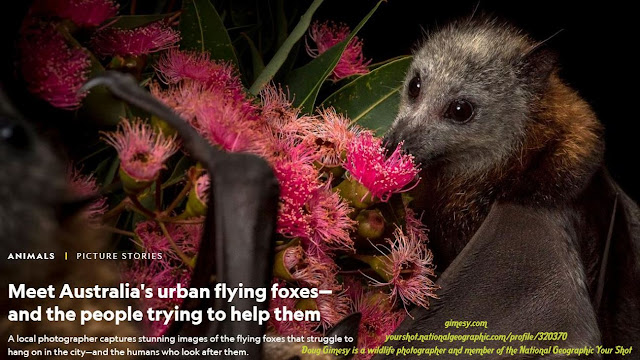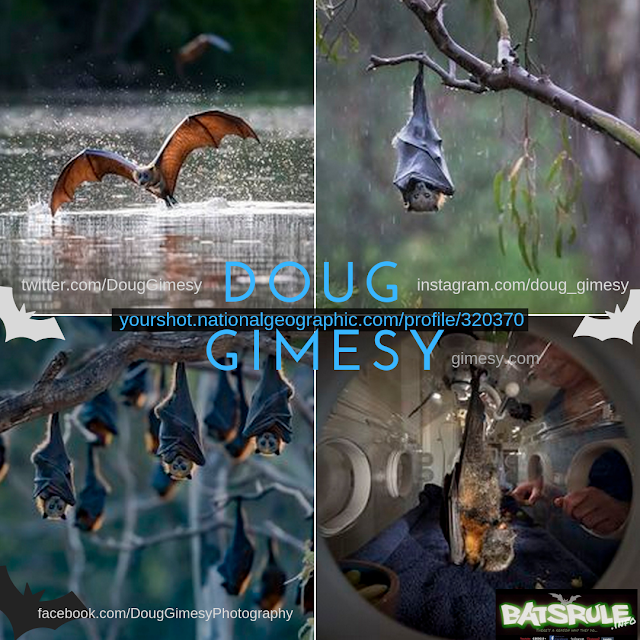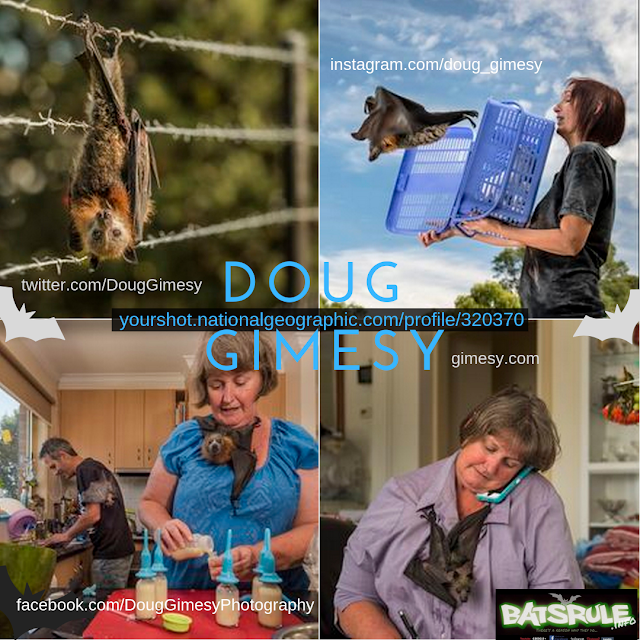Info on Bats | Meet Australia's urban Megabats and the people trying to help them DOUG GIMESY
Meet Australia's urban Megabats and the people trying to help them
A local photographer captures stunning images of the flying foxes that struggle to hang on in the city—and the humans who look after them.
Orphaned and rescued grey-headed flying-foxes feed on the pollen of native eucalyptus flowers that have been brought in as a treat. Their love of flowering plants is what makes them such important pollinators for native Australian forests.
"In this months edition of Australian Geographic (on sale today) you'll find my peice Urban Battler - a 5 page story on Melbourne's Grey-headed Flying-foxes."
PHOTOGRAPH BY DOUG GIMESY
BY LESLIE NEMO
PUBLISHED NOVEMBER 14, 2018
IT’S BEST TO keep your voice down when strolling through Melbourne’s Yarra Bend Golf Course. The sport requires peace and quiet—as do the 30,000 bats sleeping in the trees that dot the green.
Such large groups of grey-headed flying-foxes, a species of fruit-eating megabat that measures 11 inches tall, are no longer uncommon sights in several Australian cities, including Melbourne. Over the past few decades, the expansion of new urban food sources and development in the bats’ rural homes have made cities their main residence.
A rescued grey-headed flying-fox pup is looked after by wildlife caretaker Bev Brown. The bats are extremely intelligent, Brown says, and call out to their caretakers when they see them coming.
Trainee wildlife caretaker Linsell prepares breakfast for three grey-headed flying fox pups in Julie's kitchen, one of whom hangs off her hair in anticipation.
Wildlife bat rescuers, Paul and Bev, treat a grey-headed flying-fox in their kitchen. A dog attacked this bat after it was caught in inappropriate fruit-tree netting. Because of its size and strength, the bat was named ‘Tank,’ and was successfully released back into the wild.
Some rescued bats can't be released immediately back into the wild. First, they need a half-way home, where they can get used to being back in the open and fly out with other bats… Read More
A rescued grey-headed flying-fox is released back into the wild at the Melbourne camp after months of home care by Graeme, a volunteer bat rescuer and caretaker.
This migration has been a mixed blessing for flying-foxes, which face threats from urban infrastructure such as nets and barbed wire, as well as harassment from residents. But some local advocates, are fighting to help this threatened species.
“We want the bats to be here forever, or however long they choose to be here,” says Stephen Brend, the state park officer in charge of monitoring the Yarra Bend roost. The population is doing well this year, and for that to continue in an increasingly urbanized Australia, both the flying residents and their human neighbors will have to adapt.
Julie and Graeme, two wildlife caretakers, prepare a meal for several recently orphaned grey-headed flying-fox pups. In the wild the young would be hanging on their mother, but under care, they direct their affection and clinginess toward humans.
Moving to the city
Grey-headed flying-foxes have a taste for a range of different pollens and nectars—a trait that makes them essential forest pollinators. But some of their favorite plant species have recently become popular ornamentals in yards and gardens in Australian cities. More and more bats are shifting their roosts from rural areas to cities. Justin Welbergen, an ecologist at Western Sydney University and the president of the Australasian Bat Society, thinks these urban smorgasbords are the main cause.
For wildlife photographer and Melbourne resident Doug Gimesy, who is documenting how the species navigates the city, this migration of bats has essentially eliminated his commute. But most Australians don’t share Gimesy’s excitement. “Having 50,000 flying-foxes in your backyard is difficult to deal with,” Welbergen says. They smell, they make noise, and they poop. Their public image is made worse by unfounded fears about the diseases they are thought to spread.
After two months of care, a rescued and rehabilitated grey-headed flying-fox, released just seconds earlier, takes to the skies to head back home to his colony.
So almost no matter where the bats settle, local residents want them gone. For example, the Melbourne contingent of flying-foxes originally chose to roost in the Royal Botanic Gardens in the 1980s. By the 2000s, public animosity towards the bats, combined with the damage they caused to the gardens, forced park employees to usher the bats into Yarra Bend Park instead, where the department could watch over them more closely, Brend says.
Deadly encounters
Park employees can’t protect the bats when they fly off in search of food, however, which is when they really get into trouble. Residents often try to protect the fruit trees in their yards by surrounding them with barbed wire or nets, both of which can have lethal consequences for bats.
Bev Brown has been nursing sick and injured grey-headed flying-foxes back to health ever since someone dropped a baby bat off at her house 16 years ago. In 2018, she earned the Order of Australia Medal for her volunteer work. During that time, she’s seen all kinds of bat encounters.
In the summer, she says, 8 to 10 bats a day are brought in suffering net-related wounds. Entangled mothers will try and chew off their own wings to get back to their babies. And strings wound too tightly around blood vessels for too long can damage the tissue in a bat’s wing. Brown often tries to help these bats, but sometimes their wing tissue spontaneously declines, and the animal has to be put down. “The worst thing is, those big brown eyes look up at you, and you have to have it euthanized,” Brown says. “I still cry every time.”
A grey-headed flying-fox is caught under netting in a person’s yard in inner Melbourne. The nets are meant to keep the bats from eating the fruit on trees, but if the weave is too big—as is the case with this net—the bats can get trapped. Luckily, this bat was only caught under the mesh, not in it. He was successfully rescued and released into the wild 10 days later.
Even with these challenges, the Melbourne bats are more fortunate than some. Yarra Bend is a sanctioned home. Elsewhere in Australia, residents can chase the bats from their roosts whenever they like—it’s even legal to shoot them in some areas, like orchards. Still, the bats continue to migrate into cities, attracted by the fruity feasts.
The more you know
Outside city limits, developers are clearing the plants the bats feed on, as rural areas are increasingly converted into farmland and housing developments, or cut down for wood pulp. Welbergen argues that if the destruction continues, there will be fewer and fewer food options for the population, which makes habitat destruction the species’ primary threat.
Global warming puts additional pressure on the flying-fox population. During extremely hot days, which are on the rise, the bats can die from heat stress, a condition they signal by clumping together and slowly sliding down tree trunks in a furry mass. If heat waves occur in the spring, while babies are still completely dependent on their mothers, Brend says that could kill almost an entire year’s worth of offspring.
With so many factors working against the bats, its seems the only way to ensure they continue filling the night sky is to better understand their inner workings. More researchers are focusing on flying-foxes than ever before, says Welbergen, and their collective results should help craft more evidence-based rescue efforts.
In the meantime, the bats have taught Gimesy, who often travels around the world for work, the value of staying local. As a photographer, he says, “I think we should focus on issues closer to home, because those can have the most impact.”
Brend and Brown, too, will continue caring for the bats and educating the public to help them accept their nocturnal neighbors. One local department store, for example, has agreed to only sell small-weave tree netting that bats can’t get caught in. And Brown visits homes surrounding new roosts to answer residents’ questions and ease their concerns.
“People think they’re flying vermin, but I’ve raised my children with these flying mammals,” Brown says. Brend feels similarly. “People have such negative opinions about bats, and we’re trying to overcome that,” he says.
Grey-headed flying-foxes fly out over Melbourne during a warm summer’s sunset looking for food. The nightly exodus can include up to 50,000 bats. At daybreak, the flying-foxes return to the trees of Yarra Bend Park, where the parks department monitors the population and makes sure they’re healthy. In Australian cities that don’t provide the bats with a guaranteed home, residents often force the bats into resettling elsewhere.
Doug Gimesy is a wildlife photographer and member of the National Geographic Your Shot photo community. Gimesy first began submitting wildlife photos to Your Shot where he was discovered by editors and is now represented by National Geographic Image Collection. To see more of his work, visit his website and Your Shot page.
Julie and Graeme, two wildlife caretakers, prepare a meal for several recently orphaned grey-headed flying-fox pups. In the wild the young would be hanging on their mother, but under care, they direct their affection and clinginess toward humans.
Moving to the city
Grey-headed flying-foxes have a taste for a range of different pollens and nectars—a trait that makes them essential forest pollinators. But some of their favorite plant species have recently become popular ornamentals in yards and gardens in Australian cities. More and more bats are shifting their roosts from rural areas to cities. Justin Welbergen, an ecologist at Western Sydney University and the president of the Australasian Bat Society, thinks these urban smorgasbords are the main cause.
For wildlife photographer and Melbourne resident Doug Gimesy, who is documenting how the species navigates the city, this migration of bats has essentially eliminated his commute. But most Australians don’t share Gimesy’s excitement. “Having 50,000 flying-foxes in your backyard is difficult to deal with,” Welbergen says. They smell, they make noise, and they poop. Their public image is made worse by unfounded fears about the diseases they are thought to spread.
After two months of care, a rescued and rehabilitated grey-headed flying-fox, released just seconds earlier, takes to the skies to head back home to his colony.
So almost no matter where the bats settle, local residents want them gone. For example, the Melbourne contingent of flying-foxes originally chose to roost in the Royal Botanic Gardens in the 1980s. By the 2000s, public animosity towards the bats, combined with the damage they caused to the gardens, forced park employees to usher the bats into Yarra Bend Park instead, where the department could watch over them more closely, Brend says.
Deadly encounters
Park employees can’t protect the bats when they fly off in search of food, however, which is when they really get into trouble. Residents often try to protect the fruit trees in their yards by surrounding them with barbed wire or nets, both of which can have lethal consequences for bats.
Bev Brown has been nursing sick and injured grey-headed flying-foxes back to health ever since someone dropped a baby bat off at her house 16 years ago. In 2018, she earned the Order of Australia Medal for her volunteer work. During that time, she’s seen all kinds of bat encounters.
In the summer, she says, 8 to 10 bats a day are brought in suffering net-related wounds. Entangled mothers will try and chew off their own wings to get back to their babies. And strings wound too tightly around blood vessels for too long can damage the tissue in a bat’s wing. Brown often tries to help these bats, but sometimes their wing tissue spontaneously declines, and the animal has to be put down. “The worst thing is, those big brown eyes look up at you, and you have to have it euthanized,” Brown says. “I still cry every time.”
A grey-headed flying-fox is caught under netting in a person’s yard in inner Melbourne. The nets are meant to keep the bats from eating the fruit on trees, but if the weave is too big—as is the case with this net—the bats can get trapped. Luckily, this bat was only caught under the mesh, not in it. He was successfully rescued and released into the wild 10 days later.
Even with these challenges, the Melbourne bats are more fortunate than some. Yarra Bend is a sanctioned home. Elsewhere in Australia, residents can chase the bats from their roosts whenever they like—it’s even legal to shoot them in some areas, like orchards. Still, the bats continue to migrate into cities, attracted by the fruity feasts.
The more you know
Outside city limits, developers are clearing the plants the bats feed on, as rural areas are increasingly converted into farmland and housing developments, or cut down for wood pulp. Welbergen argues that if the destruction continues, there will be fewer and fewer food options for the population, which makes habitat destruction the species’ primary threat.
Global warming puts additional pressure on the flying-fox population. During extremely hot days, which are on the rise, the bats can die from heat stress, a condition they signal by clumping together and slowly sliding down tree trunks in a furry mass. If heat waves occur in the spring, while babies are still completely dependent on their mothers, Brend says that could kill almost an entire year’s worth of offspring.
With so many factors working against the bats, its seems the only way to ensure they continue filling the night sky is to better understand their inner workings. More researchers are focusing on flying-foxes than ever before, says Welbergen, and their collective results should help craft more evidence-based rescue efforts.
In the meantime, the bats have taught Gimesy, who often travels around the world for work, the value of staying local. As a photographer, he says, “I think we should focus on issues closer to home, because those can have the most impact.”
Brend and Brown, too, will continue caring for the bats and educating the public to help them accept their nocturnal neighbors. One local department store, for example, has agreed to only sell small-weave tree netting that bats can’t get caught in. And Brown visits homes surrounding new roosts to answer residents’ questions and ease their concerns.
“People think they’re flying vermin, but I’ve raised my children with these flying mammals,” Brown says. Brend feels similarly. “People have such negative opinions about bats, and we’re trying to overcome that,” he says.
Grey-headed flying-foxes fly out over Melbourne during a warm summer’s sunset looking for food. The nightly exodus can include up to 50,000 bats. At daybreak, the flying-foxes return to the trees of Yarra Bend Park, where the parks department monitors the population and makes sure they’re healthy. In Australian cities that don’t provide the bats with a guaranteed home, residents often force the bats into resettling elsewhere.
Doug Gimesy is a wildlife photographer and member of the National Geographic Your Shot photo community. Gimesy first began submitting wildlife photos to Your Shot where he was discovered by editors and is now represented by National Geographic Image Collection. To see more of his work, visit his website and Your Shot page.
Links in this story
- environment.des.qld.gov.au/wildlife/livingwith/flyingfoxes/importance
- westernsydney.edu.au/hie/people/researchers/doctor_justin_welbergen
- gimesy.com/melbournes-flying-night-gardeners
- theconversation.com/why-we-shouldnt-be-so-quick-to-demonise-bats
- wildlife.vic.gov.au/our-wildlife/flying-foxes/victorias-flying-fox-colonies
- nationalgeographic.com/animals/2019/03/endangered-bats-killed-in-mauritius
- nationalgeographic.com/animals/2018/12/killing-bats-for-their-blood
- nationalgeographic.com/animals/2018/11/daytime-bats-help-explain-nocturnal-evolution
- nationalgeographic.com/animals/2018/08/bats-hibernate-snow-winter-behavior-japan-news
- nationalgeographic.com/animals/2018/07/bats-kenya-new-species-animals
- nationalgeographic.com/magazine/2018/09/explore-through-the-lens-joel-sartore-bats-cave-uganda-marburg

























SM done
ReplyDeletehttps://www.facebook.com/BatsRule/
https://www.facebook.com/batsruleinfoonbats/
https://www.tumblr.com/blog/batsrule-info
https://twitter.com/Bats_Rule
https://www.pinterest.com.au/jcaust/bat-articles/